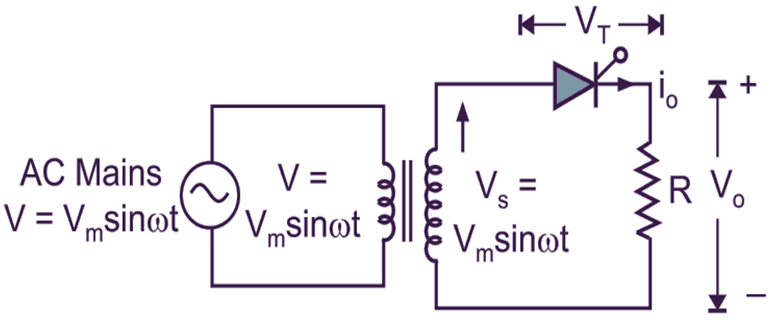A continuous gate signal is not normally desirable to trigger SCR because of the associated power dissipation in the SCR, but in applications where the SCR may turn OFF before the time required this extra dissipation must be tolerated. The resistance is used to trigger SCR. Continue reading Resistance (R) Firing Circuit (or Triggering Circuit) of SCR (Thyristor)
Category: Power Electronics
What is Single Phase Semi Converter? Working, Circuit Diagram, Waveform & Applications
Single Phase Semi Converter provides only a one-quadrant operation. Most commercial applications need only controlled rectification and for this a Single Phase Semi Converter is enough. Continue reading What is Single Phase Semi Converter? Working, Circuit Diagram, Waveform & Applications
What is Single Phase Full Wave Controlled Rectifier? Working, Circuit Diagram & Waveform
Single Phase Full Wave Controlled Rectifier is similar to Single Phase diode bridge rectifier but the only difference is that diodes are replaced by thyristors. Continue reading What is Single Phase Full Wave Controlled Rectifier? Working, Circuit Diagram & Waveform
What is Single Phase Full Wave Controlled Rectifier with RL load? Working, Circuit Diagram & Waveform
Single Phase Full Wave Controlled Rectifier with RL load consists of four thyristors T1 to T4 and they are connected in bridge configuration driving a highly inductive load. Fig. 1 (a) shows the circuit of single-phase fully controlled bridge rectifier with highly inductive load. Continue reading What is Single Phase Full Wave Controlled Rectifier with RL load? Working, Circuit Diagram & Waveform
Class C Commutation of Thyristor (SCR) | Complementary Commutation | Voltage Commutation
In complementary (or class C) commutation, the SCR carrying load current is commutated (turned-OFF) by transferring its load current to another incoming SCR. The SCR to be commutated is called main SCR and the additional SCR used for commutating the conducting SCR is called complementary SCR. In this technique of commutation, both the SCRs conduct the load current alternately. Continue reading Class C Commutation of Thyristor (SCR) | Complementary Commutation | Voltage Commutation
What is 3 Phase Converter? Types, Working & Circuit Diagram
For the large power, variable speed drives, the 3 Phase AC to DC converters are extensively used. The average output voltage of 3 phase converter provides higher and hence its D.C. output is suitable for large power DC loads. Continue reading What is 3 Phase Converter? Types, Working & Circuit Diagram
What is the Two Transistor Model (Analogy) of SCR (Thyristor)? Derivation, Diagram & Working
The SCR is a PNPN semiconductor switching device. It can be considered to be constructed by sandwitching two complementary transistors one PNP and the other NPN type. Fig. 1 (a) shows the structure of two transistor model of SCR. Continue reading What is the Two Transistor Model (Analogy) of SCR (Thyristor)? Derivation, Diagram & Working
What is Single Phase Half Wave Controlled Rectifier (with R load)? Working, Circuit Diagram & Waveform
Single phase half wave controlled rectifier consists of single thyristor feeding DC power to the resistive load, resistive-inductive load, and resistive-inductive load with a free-wheeling diode.

Fig. 1: Single Phase Half Wave Controlled Rectifier Circuit Diagram. Continue reading What is Single Phase Half Wave Controlled Rectifier (with R load)? Working, Circuit Diagram & Waveform
What is Natural Commutation (or Line Commutation) of SCR (Thyristor)?
When the input voltage is ac or line voltage, the anode current of an SCR goes to zero at the end of every positive half cycle and a reverse voltage appears across the device. The device is then automatically turned OFF due to the natural behavior of the line voltage. This commutation is called as natural commutation or line commutation. The turn-OFF method of an SCR, by applying the line (i.e. mains a.c.) voltage in which the SCR turns-OFF at every zero voltage, is called commutation of an SCR. Continue reading What is Natural Commutation (or Line Commutation) of SCR (Thyristor)?
What is Silicon Controlled Switch (SCS)? Working, Symbol & Construction
A silicon controlled switch is abbreviated as SCR. It is a unilateral four layer silicon device with four electrodes, namely anode, cathode, anode gate and cathode gate. It is a member of thyristor family. It is a unidirectional device. Continue reading What is Silicon Controlled Switch (SCS)? Working, Symbol & Construction